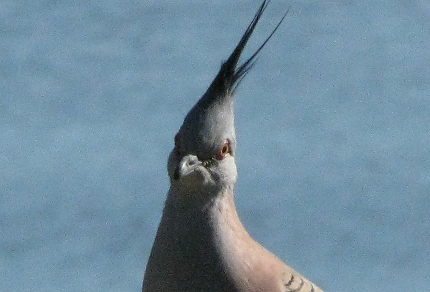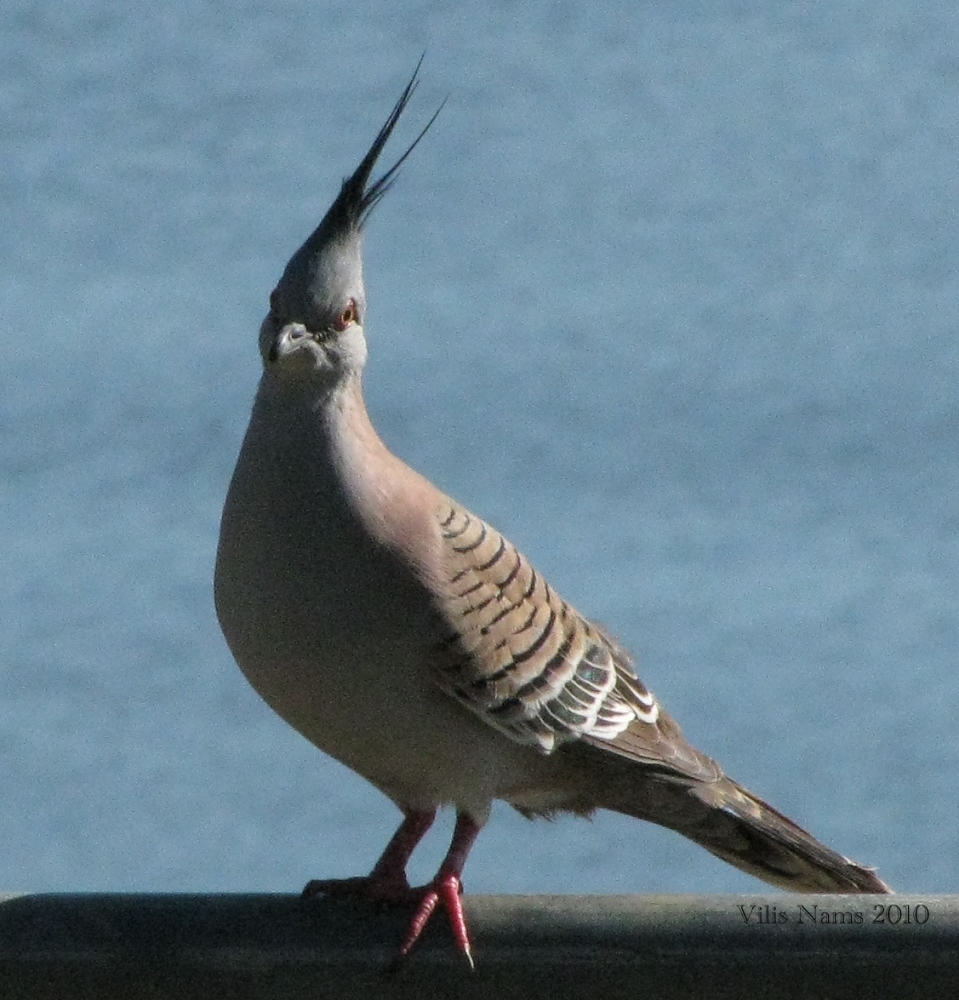Australia’s gorgeous crested pigeon has a slim, black crest, bright red feet, and uses wing whistles to warn flock members of danger.
This week we return to Australia for our featured bird, the crested pigeon, Ocyphaps lophotes. Like other pigeon and dove species, the crested pigeon is a member of the avian family Columbidae, a group of birds characterized by plump bodies and small heads. Australia is home to twenty-five species of columbids that live in habitats ranging from desert to tropical rainforest. Only two of them possess crests, the crested pigeon and spinifex pigeon.1
Sleek and handsome, the crested pigeon has a grey and tan plumage, bright red feet and a narrow, conspicuous black crest atop its head. Its wings are strongly barred with black, and each wing bears a white-edged wing patch delicately hued with green and purple.
The crested pigeon’s preferred habitat is lightly wooded grassland near water. Once restricted to Australia’s inland arid and sem-arid regions, this species has spread throughout much of the country and successfully colonized towns and cities.2
Crested pigeons feed on the ground, often in flocks. Primarily, they eat seeds but occasionally take insects and leaves.2
I first encountered crested pigeons in Townsville, North Queensland, a tropical city with a lovely old golf course and enticing greenbelt, the Ross River Parkway, near Vilis’s and my rented home. I often spotted these birds perched on wires or in trees, their crested profiles unmistakable. The pigeons would swoop to the ground, their tails lifting on landing. When they took to the air, their wings produced a whistling sound that was very useful for identification.
Australian research has shown that one variation of the crested pigeon’s wing whistle serves as an auditory defensive warning system. Research done by Mae Hingee and Dr. Robert Magrath of the Australian National University in Canberra reported that crested pigeons produce a wing whistle that alerts other pigeons to the fact that danger is near.3
By observing feeding flocks, the researchers noticed that crested pigeons’ wing whistling seemed to change when birds flew off in alarm. They hypothesized that crested pigeons were using wing-created whistles as a defensive alarm to warn other crested pigeons of danger. To test this hypothesis, Hingee and Magrath first recorded the wing whistles made by crested pigeons routinely flying away from flocks, and the whistles made by birds that blasted off in alarm when a hawk model was tossed at them from behind a blind.3
Analysis of the recordings showed that routine and alarm flight whistles were complex and distinct, with the alarm whistle being faster and louder than the routine flight whistle. When the researchers played the recording of a routine flight whistle to flocks of crested pigeons, the flocks continued feeding unconcernedly. When the researchers played the recording of an alarm flight whistle to the flocks, it was like a sentinel shouting, “Incoming!” For more than seventy percent of the flocks, the reaction to the alarm flight whistle was immediate abandonment of the feeding grounds, making it clear that the alarm wing whistle plays a significant role in the survival behaviour of crested pigeons.3
1. Graham Pizzey and Frank Knight. The Field Guide to the Birds of Australia. 2000. Angus&Robertson. Sydney. pp.242-256.
2. BirdLife Australia. Crested Pigeon. Ocyphaps lophotes. Columbidae. Accessed 17-Mar-2017. http://birdlife.org.au/bird-profile/Crested-Pigeon




